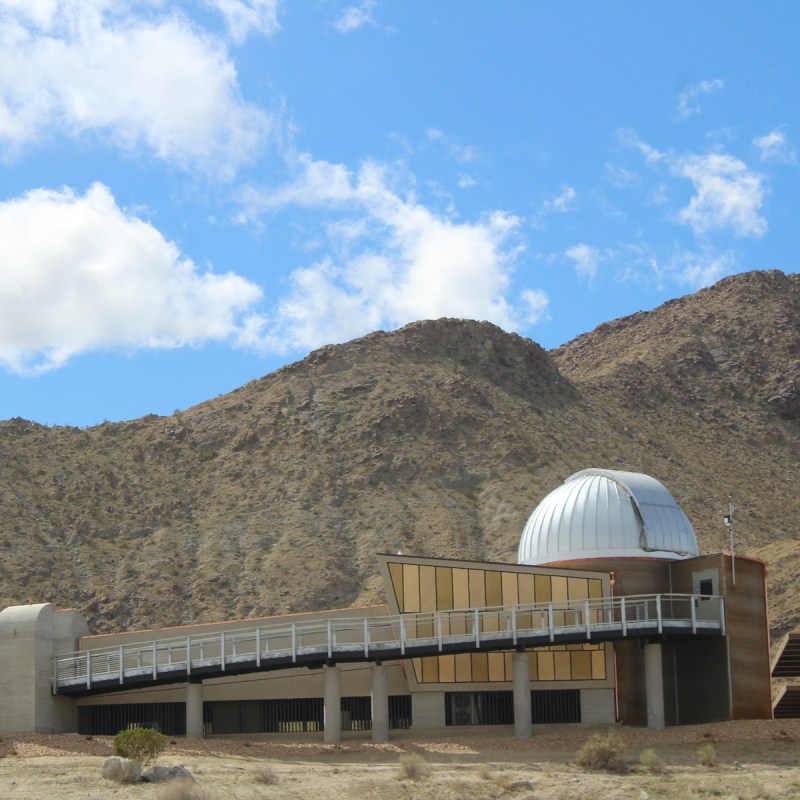
Greater Palm Springs is teeming with stars. The desert landscape of the Coachella Valley and the craggy rise of the San Jacinto Mountains make it the perfect place to see them, away from the blinding lights of nearby Los Angeles. Rancho Mirage, one of the nine cities in Greater Palm Springs, is known for sightings. Even more so, since the city opened a state-of-the-art facility at the Rancho Mirage Library complex to spot the luminaries.
Videos by TravelAwaits
The Rancho Mirage Observatory officially opened on March 25, 2018, at the western entrance of the Rancho Mirage Public Library campus. The addition enhances the library’s mission of “lifelong learning,” and its programs further public understanding and appeal to anyone interested in astronomy, from the amateur to an expert in the field. You can see the stars if you take the nine-mile drive from the Palm Springs International Airport to the observatory. Once there, you can immerse yourself in the stunning beauty of the night sky and view an incredible array of planets and galaxies far, far away. It’s become one of the top things to do when visiting Rancho Mirage, and here are a few main reasons why.
I was a guest of Palm Springs Preferred Hotels for this tour, but all opinions are my own.
An Actual Astronomer Will Be Your Guide
Eric McLaughlin worked as a mechanical engineer in San Diego before he felt the gravitational pull to become an astronomer. He enrolled at San Diego State University and completed his graduate work in astronomy. The stars aligned, and Eric found his way back to the Coachella Valley. Eric lived here as a child, and when the City Astronomer job came up at the brand-new observatory, he leaped at the chance to apply. He was thrilled to put down roots in Rancho Mirage and feels incredibly lucky he found his calling. “Seeing people come to a sense of excitement and awe at what fills the expanse around this tiny world we call home is the best part of my job.” A City Astronomer is not a common position and isn’t always community-based. Usually, the opportunity is attached to a university and is primarily focused on research. At the Rancho Mirage Observatory, Eric built the programs from the ground up. He also hosts the YouTube Channel and various stargazing events. His infectious admiration for all things space draws you in, and his ability to explain complex material makes it memorable.

Look At The Universe Through Different Lenses
Currently, there are seven different telescopes to observe the planets and the stars. There’s a Lunt H Alpha Solar telescope (for viewing the sun and its gases), three Celestron CPC Deluxe 9.25 computerized telescopes, one Celestron 6 SE computerized telescope, and one Orion SkyQuest XT10 telescope. The observatory is near the southern end of the city, where there’s an enormous buffer between the complex and typical sources of light pollution. The location makes it the perfect place to admire the sky. These outdoor telescopes are often set up on the deck and offer up to 100 times magnification.
Charlie Martin, the primary architect, designed the observatory to look like a comet from above. The central dome is the head, and the curved deck is the comet’s tail. The large outdoor patio made of ipe wood has high walls to block out any light. Families or visitors can gaze at planets, clusters of stars, and other galaxies in the evenings. Weather permitting, Eric may set up four telescopes on dedicated pads connected to the computerized control room inside.
The main telescope, the high-powered PlaneWave Instruments CDK700, is inside a remarkable dome. This device provides research-grade magnified views of the skies, up to 50 million light-years away from inside a comfortable room. The CDK700 sits on a 16-foot-high concrete pedestal that’s anchored to a 120,000-pound concrete footing. The building was built around the telescope’s pedestal to minimize the transfer of vibrations from the structure. The dome roof spins 360 degrees in either direction, and a retractable door opens to the night sky with the touch of a button. It’s an awe-inspiring way to see our universe.

The Observatory Is For Everyone
The observatory is ADA accessible and free. The construction cost $4.2 million dollars from conception to completion, funded with non-city trust fund monies. One million pounds of concrete and over 4 miles of rebar and wood make up the structure. The observatory exterior complements the library and continues operating thanks to restricted library funds. “It is a place dedicated to astronomy for the public and is a regional scientific asset, free of charge to all valley residents and visitors.”
The deck and the dome are wheelchair accessible. The astronomy team cleverly placed two refracting telescopes end to end to create a periscope for viewing the CDK700 at a comfortable height. That works well for children and citizens in wheelchairs. Inside the dome, you will observe details on planets like Mars and Jupiter. You can check out nebulae, which are enormous clouds of gas and dust, clusters of stars, and distant galaxies. When the door is closed, you can see all the constellations projected on the roof. There’s even a weather station component. While its purpose is to protect sensitive equipment, it also measures high speed winds and rain to inform the public about deteriorating weather in the area.

There Are All Types Of Programs And Events
Currently, all programs are online due to the ongoing coronavirus pandemic. When asked when programming will return, Eric hopes soon. “At this stage, we don’t expect to have large in-person stargazing events before the end of the year. COVID has made everything a moving target. Our primary goal is to have people explore the universe with their own eyes.”
When regular programming returns, you can expect observatory tours and stargazing events to return. Eric hopes to add telescope workshops for amateur astronomers. These workshops are a great way to learn how to set up and use their own instrument at the observatory and later in their backyard. Additionally, Eric will continue setting up guest speakers, host a lecture series, and eventually allow visitors to take photographs of the planets using the CDK700. When asked if there had been any requests for other events, Eric mentioned, “We’ve been approached for several different events. However, the most unusual one that comes to mind is the filming of a music video.”

Programs Are Online
There are past lectures and virtual programs on the Rancho Mirage Observatory YouTube channel. “When things shut down in March of 2020, we had our first live stream event less than a month later. We had one video that received over 30,000 views. That may be small by online standards, but it’s many times the maximum number of people we could fit into all the RMLO facilities combined. Nevertheless, I am very eager to have people onsite exploring the universe with us again.”
Eric fields questions from the viewing audience, and these shows are taped and stored on the page. Some viewers’ questions are asked consistently. That’s why the answers are posted on the FAQ section on the RMLO website. Questions such as — How far away is the nearest star? How far away is the Moon? What is a light-year? According to the answer on the observatory website, a light-year is the distance light travels in one year or (in a vacuum) 186,000 miles per second. At this speed, light travels from the earth to the moon in about 1.3 seconds!
For the purposes of this piece, I took a stargazing tour with Eric. It lasted 2 hours and started on the outdoor deck. There we looked through two different telescopes, one pointed at the moon to observe its surface, and the other pointed at Saturn to check out the rings. Then, we walked inside to experience the CDK700. As the dome spun and the retractable door opened, the telescope pointed at the Ring Nebula, a planetary nebula at about 2,300 light-years away. Next, Eric pointed the telescope toward the Hercules Globular Cluster, which contained several hundred thousand stars, about 25,000 light-years away. Afterward, he closed the retractable door and projected the constellations on the roof of the dome. He discussed their location in the sky and even added a projection of the moon.
In the words of the ancient Greek philosopher Plato, “Astronomy compels the soul to look upwards and lead us from this world to another.” It was a breathtaking experience and a tour that everyone should take when in Greater Palm Springs.
Here are some other starry-eyed sites to see in Palm Springs:
